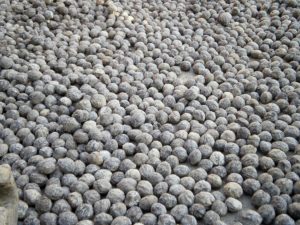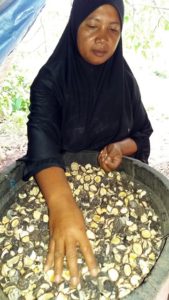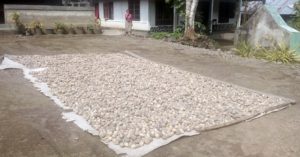
Candlenut in West and East Nusa Tenggara provinces in Indonesia has the potential to provide additional income for farmers, but post-harvest handling is necessary.
If you visit the Indonesian provinces of West or East Nusa Tenggara (collectively called Nusa Tenggara), you can easily find lush groves of candlenut trees. Candlenut (Aleurites moluccanus) can survive the provinces’ extreme dry seasons, making it the predominant provider of non-timber forest products.
Candlenut is a flowering tree that produces hard seeds containing fatty acids that yield 15-20 percent of their weight in oil. Presently, candlenut cultivation focuses on extracting the oil for use as a hair tonic, massage oil, in aromatherapy, and as a skin moisturizer. Candlenut is also an essential ingredient in many Indonesian and Southeast Asian cuisines, used as a flavor enhancer, thickener and condiment.
Farmers in Nusa Tenggara often intercrop candlenut with other species, such as coffee, and sell the whole nuts with minimal processing. Since 2013, the Developing and Promoting Market-based Agroforestry Options and Integrated Landscape Management for Smallholder Forestry in Indonesia (Kanoppi) project, which is funded by the Australian Centre for International Agricultural Research and the CGIAR Research Program on Forests, Trees and Agroforestry (FTA), has been working with candlenut farmers to help them improve their livelihoods.
“Like many others in Indonesia, candlenut farmers in Nusa Tenggara follow very traditional methods,” said Aulia Perdana, Kanoppi leader. “They acquired their farming techniques from their parents and, owing to a lack of access to specialist knowledge, usually don’t try to innovate. As well, a lot of projects on candlenut have focused on production without incorporating downstream aspects, like marketing, and this is where Kanoppi contributes.”
Read more: Lack of knowledge may impede economic potential

Perdana said that Kanoppi, now in its second phase, would continue its focus on marketing while exploring more partnerships with the private sector and optimizing production through sustainable management using an integrated landscape approach.
Annually, a candlenut tree produces 30-80 kg of nuts. After shelling, the nuts weigh 25 percent of the original mass and sell for between Rp 10,000 (75 US cents) and Rp 25,000 per kilogram.
In 2016, one of the partners in Kanoppi, Universitas Mataram, conducted a pilot study in Batudulang village, Sumbawa, West Nusa Tenggara, which found that farmers already performed simple post-harvest processes, such as drying the nuts in the sun or with small concrete ovens, soaking the nuts and cracking the shells with tools made from used plastic bottles.
The university compared the difference in revenue between selling whole or processed nuts: 10 kg of whole nuts could be sold for Rp 40,000 whereas dried and shelled nuts sold for Rp 60,000 and the shells for Rp 3,500. Assuming that farmers processed the nuts themselves rather than paying others, the revenue for 10 kg of processed nuts was higher by Rp 23,500 than the same amount of whole nuts.
In practice, if farmers wanted to expand production to include processing, they needed to hire workers, which meant they had to pay wages and transportation costs. Yet when analyzed, the results were still profitable. The university calculated that if the processors handled 1 ton of whole nuts per day they could generate Rp 471,170 of profit, or more than Rp 12,000,000 per month.
Another Kanoppi partner, Threads of Life, conducted field observation of the candlenut value chain in Gunung Mutis, East Nusa Tenggara. They found that farmers and village collectors usually sold to agents who worked for district traders who then sold to larger-scale traders in Kupang and Atambua, who subsequently shipped the product to Surabaya in East Java.
The researchers also discovered that trust was an issue between farmers and traders. Farmers claimed they were paid below market price and that manipulated scales were used to weigh their yields.
On the other hand, traders claimed that sacks might not be fully filled with candlenuts. One trader in Kapan market, Gunung Mutis, said he bought a 7 kg unsorted sack in which he found 1 kg of the overall weight to be dirt and sawdust. According to the researchers, one of the solutions to the lack of trust could be selling through a village-owned enterprise, which could provide competitive prices and services to attract farmers to sell directly to them rather than to village traders.
Read more: Getting down to business: Seminar promotes shift toward inclusive investment

Kanoppi partners Threads of Life and the University of Western Australia conducted a five-day workshop for farmers in Timor Tengah Selatan, East Nusa Tenggara. The workshop focused on making cold-pressed coconut and candlenut oils and building awareness of business approaches. Sixteen participants attended, including women who played pivotal roles in value chains: determining who to sell to, negotiating prices and making deals.
It was imperative for women to understand the production processes and business planning because they could use the knowledge in bargaining and in better marketing of the product.
During the workshop, the participants decided to form a group to market their candlenut oil to the massage spas and restaurants of the neighboring island of Bali, one of the world’s top tourist destinations. Threads of Life identified Bluestone Botanicals as a potential buyer.
When presented with samples, the company’s buyers were so impressed that they instantly bought the remaining stock and committed to buying 10 liters a month from the group. To further promote candlenut production, Kanoppi shared the workshop manual with local communities in Sumbawa and Timor Tengah Selatan, East Nusa Tenggara.
By ICRAF communications specialist Robert Finlayson and independent communication consultant Enggar Paramita, originally published at ICRAF’s Agroforestry World.
This work forms part of the CGIAR Research Program on Forests, Trees and Agroforestry (FTA), which is supported by CGIAR Fund Donors.











